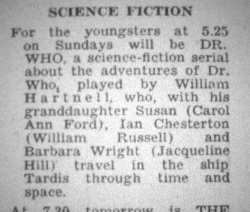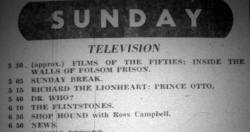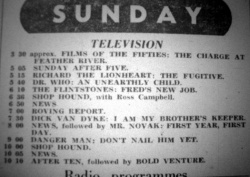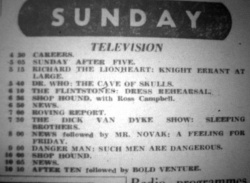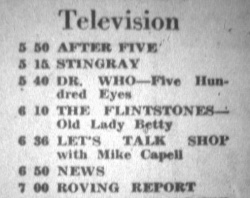Rhodesia / Zimbabwe
This country, located in south east Africa, was known as RHODESIA until 1 June 1979 when it was renamed ZIMBABWE RHODESIA. Previously a British colony, it achieved independence in 17 April 1980, when it was renamed just ZIMBABWE. It was a member of the British Commonwealth until 2003. It shares a border with Zambia.
Contents |
Profile
| Country Number (9) | 1965 | FIRST and THIRD WAVE |
| Region | Africa | Commonwealth (until 2003) |
| Television commenced | 1960 | |
| Colour System | 1984 | PAL |
| Population | 1966 | 4,136,000 |
| TV Sets | 1966 | 39,000 |
| Language/s | English |
Television Stations / Channels
South Rhodesia began its television service in 1960, and North Rhodesia began its service a year later.
There is just one television station: Rhodesian Broadcasting Corporation (as it was called at the time), a government-owned commercial broadcaster.
Colour transmissions began in 1984 using the PAL colour broadcast system. When Doctor Who screened in 1980, the episodes would have been broadcast in black and white.
However, this does not necessarily mean that the episodes were supplied in that format – i.e. as 16mm black and white film prints. Although the 14 episodes that aired in 1980 may have been Jon Pertwee stories - as the BBC was still marketing his stories as 16mm film prints in that year (as was the case with Bangladesh) - there is strong supporting evidence that these serials may have actually been Tom Baker stories.
The biggest clue that these were supplied on video tape lies in the fact that on 1 January 1981, the SF series Blakes 7 commenced. That series was never telerecorded onto film, so must have been supplied on colour video tape. The same would have been the case with Doctor Who.
This would be the only known instance in the broadcast history of Doctor Who in which Tom Baker stories were transmitted at source in black and white.
Language/s
The principal language of Rhodesia / Zimbabwe is English.
DOCTOR WHO IN RHODESIA / ZIMBABWE
Rhodesia / Zimbabwe was the ninth country to screen Doctor Who (see Selling Doctor Who). It was the second in Africa.
BBC Records
The Stanmark Productions Ltd advertisement from 1966, identifies Rhodesia as being one of the twelve countries screening Doctor Who in that year.
The Seventies records a sale of "(11)" stories by 28 February 1977. The Handbook identifies these as being: A, B, C, D, E, F, G, H, J, K, L.
In DWM, Rhodesia / Zimbabwe is identified in the Archives of the same 11 stories.
The Eighties - THE LOST CHAPTERS records a sale (by 10 February 1987) of "(4)" stories to Rhodesia and "(4)" to Zimbabwe. Rather than this being a total of 8, it's more likely the record means 4 total to "Rhodesia / Zimbabwe". Certainly the breakdown of the available episodes supports there being only four stories in total.
Stories bought and broadcast
WILLIAM HARTNELL
Eleven stories, 53 episodes:
| A | An Unearthly Child | 4 |
| B | The Daleks | 7 |
| C | Inside the Spaceship | 2 |
| D | Marco Polo | 7 |
| E | The Keys of Marinus | 6 |
| F | The Aztecs | 4 |
| G | The Sensorites | 6 |
| H | The Reign of Terror | 6 |
| J | Planet of Giants | 3 |
| K | The Dalek Invasion of Earth | 6 |
| L | The Rescue | 2 |
Rhodesia therefore bought the standard package of stories from GROUPs A, B and C of the William Hartnell stories.
The programme was supplied as 16mm black and white film prints with English soundtracks.
Origin of the Prints?
Nigeria was the previous African country to screen the William Hartnell stories in 1965, so it’s possible that Rhodesia was sent the same set of prints shortly after transmission in Nigeria. As noted below, the series' debut in Rhodesia was delayed by three weeks, presumably as a direct result of a late supply of the films.
TOM BAKER
Four stories, 14 episodes:
The titles are not confirmed, but it is likely to have been these four stories, as these were a standard package being offered by the BBC at the time, and they fit the episode count:
| 4A | Robot | 4 |
| 4B | The Sontaran Experiment | 2 |
| 4C | The Ark in Space | 4 |
| 4D | Revenge of the Cybermen | 4 |
Zimbabwe therefore may have bought part of GROUP A of the Tom Baker stories.
The programme would have been supplied on PAL colour video tapes with English soundtracks, however they would have been broadcast at source in black and white, as Zimbabwe did not introduce colour transmissions until 1984.
Transmission
WILLIAM HARTNELL
.
The series was due to debut on Sunday, 5 September 1965, at 5.40pm. The listing for that date actually said "DR WHO?", which might indicate some uncertainty as to whether it would screen. The series was also listed the following week, 12 September, this time without the question mark. However, on 19 September, the slot was filled by Forest Rangers, which was the series that had previously occupied the 5.40pm timeslot.
Rhodesia finally saw the first episode on Sunday, 26 September 1965, at 5.40pm. The series remained on that day and timeslot until at least 9 January 1966. TV listings after that date have not been located. If the series aired uninterrupted, then it ran until 25 September 1966.
Fate of the Prints
Rhodesia sent its prints to Zambia, a fact recorded in Zambian newspapers; as a direct result of Rhodesia's own delay at starting the series on its intended date, Zambia's debut was similarly held up by four weeks… Ironically, episodes of The Forest Rangers were used to plug the gaps in Zambia as well!
TOM BAKER
Fourteen years later, the series returned in 1980.
For 14 weeks from Thursday, 2 October 1980 until 1 January 1981 viewers saw Doctor Who at 6.15pm.
According to The Eighties, there were 4 stories to air prior to 1987. As noted above, it's more than likely these were four Tom Baker stories rather than Jon Pertwee. These screened in black and white, making Zimbabwe the only instance of Baker being broadcast in black and white.
TV listings
| ← AIRDATES ...... (CLICK ICON TO GO TO TABLE SHOWING EPISODE BREAKDOWN AND AIRDATES - N/S = story title is Not Stated) |
TV listings have been obtained from the newspaper The Rhodesia Herald.
1960s
For the Hartnell episodes, the listings for "DR WHO" appeared in a TV and Radio pull-out guide that was published in the Saturday edition, and which covered the up-coming week's programmes. Unfortunately, the supplement for 15 January 1966 carried TV listings for the Saturday only, and after that, the supplement was either no longer published, or simply not photographed during the transfer to microfilm. Therefore listings are not confirmed after Marco Polo episode three, and are therefore assumed in the Airdates guide.
As noted above, the series was supposed to start on 5 September 1965. The pull-out Guide in the 28 August paper carried a small preview for programmes starting "next week", and said: "For the youngsters at 5.25 on Sundays will be DR WHO, a science-fiction serial about the adventures of Dr Who, played by William Hartnell, who, with his granddaughter Susan (Carol Ann Ford) [sic], Ian Chesterton (William Russell), and Barbara Wright (Jacqueline Hill) travel in the ship Tardis through time and space.
In the 4 September 1965 paper, the first after the delayed premier episode, there was a small feature: "WAR WAGED ON THE EARTH", which said "Dr Who, a science-fiction serial, will soon be telecast by RTV. Pictured here is a being from one of the six outer galaxies that wage war on Earth". Accompanying the text was a publicity photograph of Trantis, from Mission to the Unknown, made on 6 August 1965, but which had not yet screened in the UK. (It aired on the BBC on 9 October 1965.) The fact that they say "will soon be telecast of RTV" and yet there was also a billing for the series in the 5.40pm Sunday slot, highlights uncertainty as to whether or not the episode would play.
(Of note, the very same text description of UGH (United Galactic Headquarters) meeting on "the planet Varga" appeared a few weeks later as part of the Zambia News 's 19 September 1965 preview of "DR WHO" due to shortly screen in Zambia. Obviously both countries were supplied with the same publicity material by the BBC when they were supplied with the episodes.)
1980s
In 1980, the listings gave the title as "Dr Who". None of the 14 episodes was given a story title.

